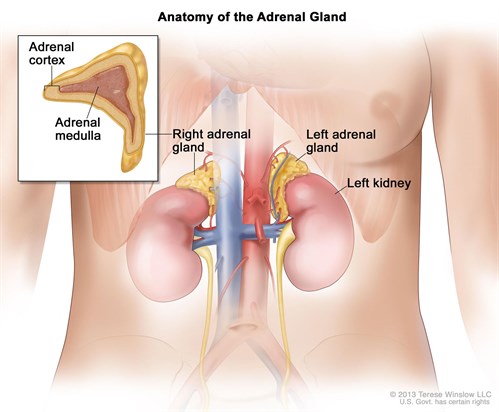Overview
Adrenal glands
One adrenal gland sits above each of your kidneys. Your two adrenal glands produce various hormones that help regulate your metabolism, immune system, blood pressure, blood sugar and other essential functions.
Most adrenal tumors are noncancerous (benign). You may require surgery to remove an adrenal gland if the tumor is producing excess hormones or is large in size (more than 2 inches or 4 to 5 centimeters). You may also require surgery if the tumor is cancerous (malignant) or suspected to be cancerous. This surgery is called adrenalectomy (uh-dree-nul-EK-tuh-me).You may also need an adrenalectomy to remove cancer that has spread (metastasized) from another location, such as the kidney or lung.
If both adrenal glands are removed, you will need to take supplemental hormone medications. If only one gland is removed, the other will take over full function without the need for ongoing medications.
Types of adrenalectomy
Surgeons may perform an adrenalectomy through minimally invasive (laparoscopic) or traditional open surgery, or use cryoablation. The procedure they recommend depends on the size and type of tumor or the condition affecting your adrenal gland.
- Minimally invasive surgery. Endocrine surgeons at Mayo Clinic are often able to use minimally invasive (laparoscopic) surgery for tumors of the adrenal gland because the gland is relatively small. Laparoscopic surgery has many benefits, including smaller scars, less pain and a shorter recovery period than traditional open surgery.
An alternative approach to laparoscopic surgery is a posterior retroperitoneoscopic adrenalectomy (PRA), in which surgeons make small incisions in your back. Sometimes surgeons use the robotic da Vinci Surgical System to perform laparoscopic adrenalectomies.
- Open surgery. Doctors usually reserve open surgery for large or cancerous (malignant) tumors. They perform open surgery using traditional instruments and incisions.
- Cryoablation. In addition, Mayo Clinic doctors may use cryoablation to treat adrenal tumors. This procedure uses CT imaging to guide the insertion of a probe that freezes and destroys adrenal tumors. Interventional radiologists may use cryoablation as a treatment option for small tumors that have spread to the adrenal gland (metastasis), particularly when surgery carries a high risk.
Your doctor can explain your treatment options and discuss whether an adrenalectomy is the most appropriate treatment for you.


Post a comment